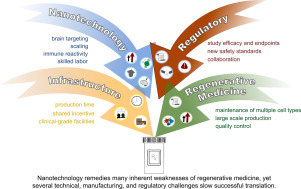Advanced Drug Delivery Reviews ( IF 16.1 ) Pub Date : 2019-05-14 , DOI: 10.1016/j.addr.2019.05.003 C L Nemeth 1 , A S Fine 2 , A Fatemi 1

|
The focus of regenerative therapies is to replace or enrich diseased or injured cells and tissue in an attempt to replenish the local environment and function, while slowing or halting further degeneration. Targeting neurological diseases specifically is difficult, due to the complex nature of the central nervous system, including the difficulty of bypassing the brain's natural defense systems. While cell-based regenerative therapies show promise in select tissues, preclinical and clinical studies have been largely unable to transfer these successes to the brain. Advancements in nanotechnologies have provided new methods of central nervous system access, drug and cell delivery, as well as new systems of cell maintenance and support that may bridge the gap between regenerative therapies and the brain. In this review, we discuss current regenerative therapies for neurological diseases, nanotechnology as nanocarriers, and the technical, manufacturing, and regulatory challenges that arise from inception to formulation of nanoparticle-regenerative therapies.
中文翻译:

使用纳米技术推进再生疗法治疗神经系统疾病的转化挑战。
再生疗法的重点是替换或丰富患病或受伤的细胞和组织,以试图补充局部环境和功能,同时减缓或阻止进一步的退化。由于中枢神经系统的复杂性,包括绕过大脑自然防御系统的困难,特别是针对神经系统疾病是困难的。尽管基于细胞的再生疗法在某些组织中显示出前景,但临床前和临床研究在很大程度上未能将这些成功转移到大脑中。纳米技术的进步提供了中枢神经系统访问,药物和细胞输送的新方法,以及新的细胞维持和支持系统,可以弥补再生疗法与大脑之间的鸿沟。在这篇评论中,



























 京公网安备 11010802027423号
京公网安备 11010802027423号